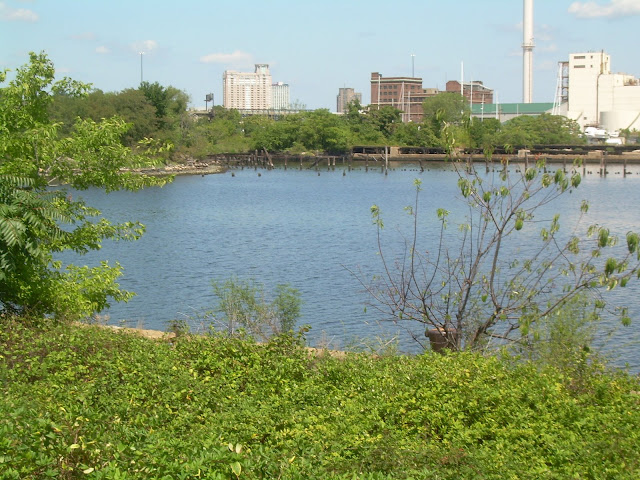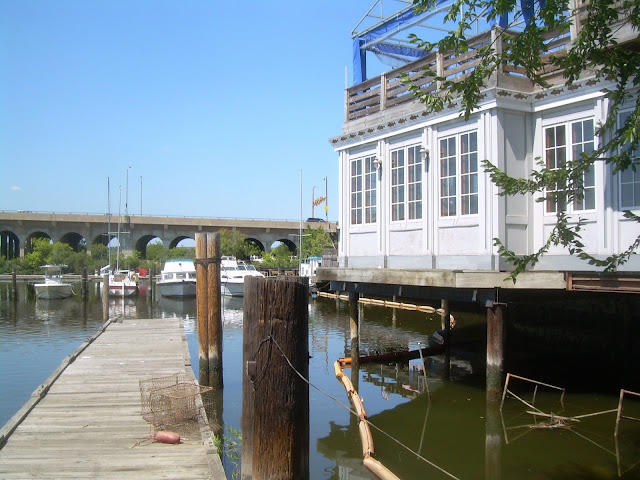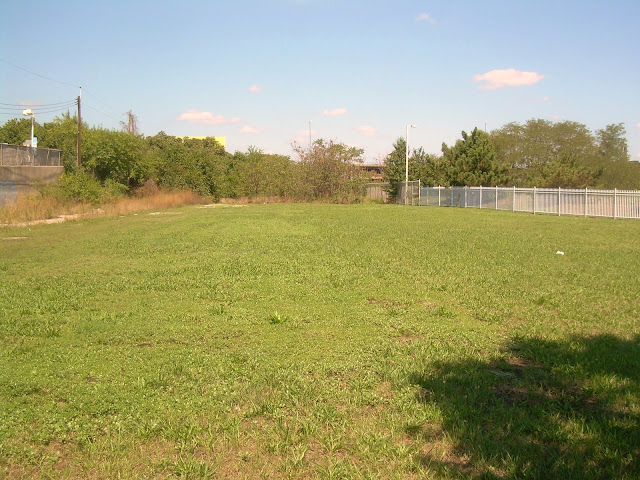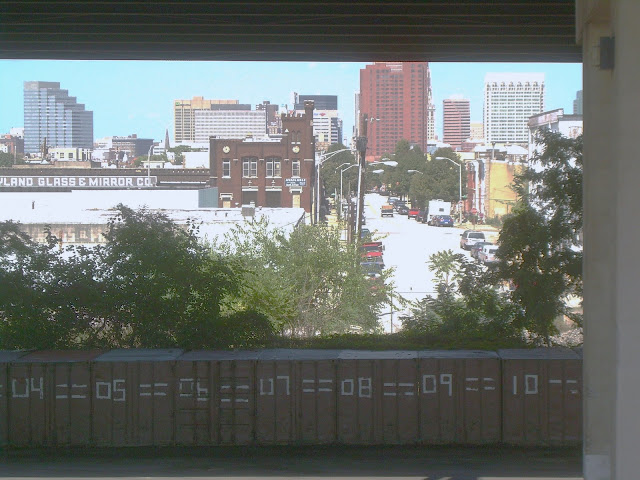Port Covington is a perfect example of the problem that urban planners have with timing. Back in the 1980s, the huge old Western Maryland railroad yard on the north shore of the Middle Branch near I-95 was carved up by the CSX Corporation for redevelopment. City planners recognized this as a fantastic site for a huge bustling high density urban development, with a great waterfront, strong proximity to downtown and excellent access to Interstate 95. But a recession, a savings and loan scandal, and ongoing urban malaise made for lousy timing for any kind of grand ambitious vision.
But there was one business organization that was still thinking big - the Baltimore Sun. The Sun was talking about building a huge new headquarters out in the suburbs. They wanted to convey their optimism for the growth of their newspaper by elbowing their way into Washington Post territory.
This was viewed as a dire threat by Baltimore boosters. What could be worse than losing your hometown newspaper to suburban flight?
So a big complicated land deal was worked out between the Sun, the City and CSX to provide the Sun with a huge parcel in Port Covington. The Sun built a sprawling state-of-the-art printing press on one part of the land (see photo above), but they had plenty left over, including virtually the entire vacant plot shown above, and an even bigger parcel on the other side of the building. The Sun's original stated intention was to save the rest of the land for the eventual relocation of the entire business, editorial and other offices that are still located in their longtime downtown headquarters. The Sun's Port Covington compound was so big that they even gave it its own name - Sun Park - which sounds vaguely Korean, perhaps suggesting the perceived remoteness of it all. But the name doesn't seem to have caught on.
The Sun printing press set the tone for the rest of Port Covington - a huge horizontal structure that seems almost insignificant on a piece of land that is very much larger, surrounded by vast open spaces which in turn are surrounded by a security fence and gates that give it a forbidding feeling.
It is hard to say how potent the Sun's suburban threat ever was. Wouldn't the Sun lose its very identity if they moved away from their city home? Two decades later, the Sun's editorial headquarters is still downtown and Port Covington remains merely a remote adjunct for printing. It's not in the suburbs but it might as well be. Meanwhile, the newspaper business as a whole is suffering from a deepening identity crisis as "professional journalists" are getting increasingly defensive about the threats from other media, especially the internet.
But the vast Sun compound did establish the course for Port Covington's further development as a huge otherworldly enclave that still seems oblivious to the surrounding city. The only other significant project in the ensuing time has been a Wal-Mart and Sam's Club - two brands of the same retail empire.
Wal-Mart and Sam's Club were built straight from the suburban mold - sprawling one story buildings next to a vast sea of parking and situated so that they totally turned their backs to the adjacent waterfront. This is astonishing in a city that is seen as a pioneer and leader in the whole concept of waterfront-oriented development.

Here's a photo of Sam's Club, blocking the waterfront behind it. There's also lots of land left over.
It is hard to say whether the Sun complex or Wal-Mart/Sam's Club has been the worst drag on achieving Port Covington's urban potential. They each have their own iconic value. Wal-Mart, of course, is almost universally perceived by "progressives" to represent all that is wrong with capitalism, America, the globalism conspiracy, etc., etc. Similarly, bigtime newspapers are perceived by "the vast right wing conspiracy" as the source for liberal propaganda and the creeping march toward pinko socialism, etc., etc. But politics makes strange bedfellows, and the Sun must cater to Wal-Mart to attract advertising. The Sun also defended Wal-Mart against State legislation aimed at forcing them to pay more employee health care benefits.
Whatever way you look at it, the Sun and Wal-Mart are two huge blotches against the previously vast potential of Port Covington as a productive urban area.
THE BRIGHT SIDE OF PORT COVINGTON
The good news is that neither Wal-Mart or the Sun are doing very well at Port Covington, so they should both be amenable to change. It has recently been announced that Sam's Club is closing up the Port Covington store, so it should be interesting to see what takes its place. Will it be an obviously marginal business of some sort, chosen as a short-run space filler? That would probably be the best-case scenario, because in the long run, the Sam's Club building must go - it occupies and sqaunders one of Port Covington's choicest waterfront sites.

Here is a look at a waterfront view from the rear of Sam's Club
that hardly anyone gets to see.
Meanwhile, the Sun has a dwindling circulation and so they probably realize that the huge swaths of land that surround their Port Covington printing press should not be held for future newspaper expansion, but should instead be treated as an economic asset for future development.
Other good news is that the rest of the South Baltimore peninsula is almost totally built-out now, and Port
Covington is the final frontier. There is still more pent-up demand for the type of urban environment enjoyed by people in Federal Hill, Riverside Park and Locust Point. So the challenge will be to make Port
Covington the next phase in the growth of South Baltimore, rather than the isolated wasteland that it is now. Planners have notoriously bad timing, but perhaps now is finally the time for the urbanization of Port
Covington.

Finally, there is the fact that Port
Covington is so huge that even with a couple of giant blotches like the Sun and
Wal-Mart, there is still plenty of space to work with. The security fence surrounding the Sun printing plant site can be significantly tightened up, essentially treating it as a buffer in a manner similar to the very secure Federal Reserve Bank compound in
Otterbein. This would free up a vast amount of new acreage for development.
Wal-Mart should be retained and treated as an anomaly. In the post modern era, irony is an accepted sign of the times.
Wal-Mart is as image conscious as any other big retail business and they should relish the opportunity to adapt themselves to a real urban environment. They should realize by now that the old suburban paradigm certainly does not work at Port
Covington, so in order to thrive, they should be ready for something new. On the other hand,
Wal-Mart is already right next to the huge Locke Insulator complex which predates everything else around it, so the scale of the buildings can be worked with.
Wal-Mart can thus be a transition between old heavy industry - no longer an aggressive threat in the post-modern world - and the new urban world of Port
Covington.

The entrance to
Wal-Mart has a great perpendicular view of the waterfront, so that can be exploited.
Wal-Mart's parking lot is the key to creating an urban environment. It is now essentially a "land bank" for creating a new
urbanism out of the old asphalt wasteland. With Sam's Club out of the way, this will become valuable waterfront land with real streets, buildings oriented to the streets and the water, and decked parking.
CREATING AN URBAN IDENTITY
If we could turn back the clock to the 1980s and convince everyone that there would indeed be a time in the not too distant future when the demand for a South Baltimore style urban environment could overflow into Port Covington, then obviously the Sun, Sam's Club and Wal-Mart as we know them could have been averted. We would now have a blank canvas on which to construct the ideal Port Covington urban utopia.
But we don't, which may be OK. Urban planners often seem to do better when they have constraints anyway. The sensation of unlimited space is a major part of what got us into trouble in Port Covington in the first place, just as it often tarnished suburbia and the wild western frontier. The reasoning was: Port Covington had a huge amount of land, so why not just give huge amounts of it to the Sun and Wal-Mart? It was the modern version of 40 acres and a mule.
But urban space often is more successful with a context and a legacy than it is with a blank canvas. At Port Covington, we'll probably need both. We need all the help we can get.
Even Wal-Mart is a start. The City would love to have an urban Wal-Mart. Well, maybe the yuppies would hate it, but even they need to have something to rag about, and contrary to statements from some quarters, the entire city has not yet turned totally yuppie and there are still some people who live in houses worth under $200,000 and on down to about $2,000. These people need Wal-Mart products even if the vocal urbanistas don't.
So since the City has been unable to attract Wal-Mart to downtown or any other urbanized area, the City needs to try to extend its urbanized area to Wal-Mart.
There are a few other themes to work with. There is the new cruise ship terminal at the east end of Port Covington near the south end of Key Highway. Putting the cruise ships at Canton Crossing or Allied/Harbor Point was previously contemplated, but the conclusion was that they weren't really all that appropriate for a high density urban area after all, so they ended up at Port Covington. So what we have here isn't really an urban activity generator, but just another icon - a pleasant reminder of Gopher, Julie, Issac, and Doc on the "Love Boat". We'll take what we can get.
On the other end of Port
Covington west of Hanover Street, there is a new non-museum complex being built by our National Aquarium. No, it's not an Inner Harbor-style activity generator, but it should be nice to look at.

Then there is Nick's Fish House (pictured above), wedged on a very isolated piece of the waterfront between the Locke Insulator complex and the Hanover Street Bridge. It's oldie and moldy enough so that some legends could be written about it, and these legends could serve the purposes for creating human interest whether they are true or not. Currently,
HBO's "The Wire" is using Nick's Fish House as a production staging area, so maybe the legends are being written up right now. The next step would be to adapt the legends for the new development marketing campaigns.
So perhaps there is enough life in Port
Covington so that an urban scene could spontaneously erupt, lit by the spark of big developers' money.

Besides South Baltimore, there is also much anticipated zillion dollar activity in Westport that could wash over to the Port Covington side of the Middle Branch. The photo above looks west at Westport (in the background) from Port Covington. There is talk of rebuilding the old Western Maryland Railroad bridge between the two sides for pedestrians and bikes. But it would probably have to wait until enough new "critical mass" was built in Westport to give it a good reason to be built and not a bridge from nowhere, much less a bridge to nowhere.
All of this would be great, but it is probably not enough.
CREATING AN URBAN LIFELINE
Vast open spaces are not the only asset of Port Covington which could also be a liability. The excellent highway access is also a double edged sword. The big Interstate 95 overpass with McComas Street underneath creates a formidable barrier on the north side of Port Covington, and Hanover Street is also a barrier on the west side. The ramps, the loops, and the "jughandle" at Hanover and Cromwell help to preserve the traffic carrying capacity of the road system but add to the confusion. Hanover Street also bisects Port Covington into two pieces.
Not much can be done about the traffic. This road system channels traffic so that the traffic patterns in the rest of the South Baltimore are tolerable. Before the I-95/395 system was built, traffic on Hanover Street was intolerable all the way northward to Montgomery Street and the Inner Harbor, but now much of the traffic is channeled away and Hanover Street north of Port Covington is fairly livable (although not as livable as it should be.)
The "
jughandle" at the intersection of Hanover and Cromwell Streets cannot carry much more traffic than it does now, and converting it to a normal intersection with left turn lanes would be much worse, especially for traffic coming off of I-95. It would also be exceedingly expensive to widen the Hanover Street bridge to add capacity.

The original Port
Covington plan from the 1980s called for new roads to be built north of Cromwell Street, including an underpass under Hanover Street where railroad tracks used to go (see photo above taken from
Dickman Street west of Hanover). This would create a new unimpeded connection between the portions of Port
Covington on either side of Hanover Street, and provide a route for traffic to divert away from the
jughandle.

The land for the road that would connect from this underpass to Cromwell Boulevard was reserved and never sold to the Sun. This right of way is shown above, looking northward from Cromwell. Hanover Street is just up the embankment to the left, while the Sun property is delineated by the white fence to the right.
Building these streets would allow the traffic jughandle to be eliminated and replaced with a street grid with more uniform urban design standards. Creating these new streets would be a way to open up a large amount of land to intense development on the western portion of the Sun property just to the east of Hanover Street and to the west of Hanover near Dickman Street.
This could be a strong impetus to reconfigure much of the Sun site to make it more amenable to urban development, from Hanover Street all the way eastward to the Wal-Mart site. The key is to make all of Port Covington flow in an integrated manner, to create a perception of a large waterfront community. Right now, the Sun property does not feel like waterfront land. It does not even feel like it is attached to anything, for that matter. But geographically, the Sun property is at the heart of all of Port Covington. A new urban grid street system that flows from the waterfront across Cromwell Boulevard into the Sun site and then proceeds under Hanover Street to the west will truly integrate everything. The Sun land will then become far more valuable for something new, rather than simply part of a long vain wait for another golden age of newsprint.
The street built in the grass shown above can be given special significance by giving it one of Baltimore's most venerable names - Charles Street.
AN UMBILICAL CORD FOR URBAN TRANSIT

It indeed appears to be feasible to build an extension of either Light or Charles Street, or even both, southward from the Riverside Park neighborhood of South Baltimore into Port
Covington. Both streets are slightly higher than the
CSX freight tracks just beyond where the streets now end south of Wells Street, and there is sufficient room to build overpasses over the tracks.
The photo above shows the current south end of Charles Street looking north from McComas Street. The Interstate 95 structure is at the top of the photo and the CSX Locust Point Branch is at the bottom. A southern extension of Charles Street into Port Covington could weave on a bridge between these two layers.
This would allow the urban texture of South Baltimore to weave into Port
Covington as well. In the photo above, the cool
crenulated tower of the former Pabst Brewing Company is shown on the left side of Charles in the near background, and could serve as a symbolic transition point to South Baltimore from Port
Covington.

This photo shows where such a new Charles Street extension would go as it enters Port Covington, just south of I-95. It could use either an existing underpass under McComas Street (shown above at left) or it could intersect McComas at-grade. The underpass is now occupied by a railroad track which once connected from the Western Maryland yard to the CSX Locust Point Branch. The track is still usable but does not look like it is much used, if ever. The Sun plant has a freight siding (shown above at right), just as the downtown Sun plant once had on Guilford Street. The new southward extension of Charles Street, Light Street (or the combination of both) could easily share the McComas underpass with the freight track.

There are many options for urbanizing McComas Street, which weaves around the catacombs under I-95. It does not carry a huge amount of traffic and therefore can be tailored to suit new development. The space under I-95 could be used for parking or even for a farmers market, like the downtown space under the Jones Falls Expressway. Urban development fosters such creativity.
As a result of all this, the existing urban fabric of South Baltimore could essentially be extended into Port Covington. This would be an umbilical cord for an instant sense of unity and extend South Baltimore's urban identity into Port Covington.
It would then be easy to walk or ride a bike between South Baltimore, or even downtown, and Port Covington, while never letting go of the urban connection. A local bus line would naturally follow, providing a far better alternative than the convoluted branches of the #27 and #64 lines that serve Port Covington now.
To provide maximum stimulation for new development, a streetcar line could be built down Charles and/or Light Street to Port Covington, as an extension of the line now being studied by the Charles Street Development Corporation. The full extent of the streetcar line would be from Hopkins University and Charles Village through downtown to Federal Hill to Port Covington.
A streetcar line would be the ultimate unifier for Port Covington.
We will know that Port Covington has really arrived when the same yuppies who go to the Port Covington farmer's market to buy their organic dolphin-safe vegan products then proceed onward to the reborn politically correct Wal-Mart to buy crafts for world peace made by non-sweat shop adult artisans.
